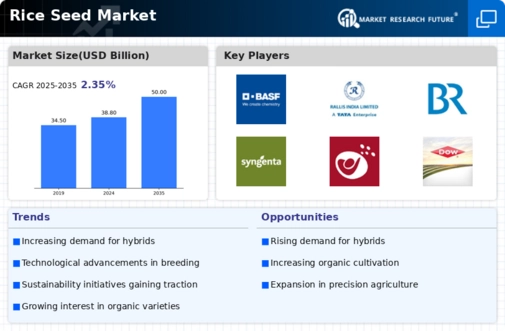Rising Global Population
The increasing global population is a primary driver of the Global Rice Seed Market Industry. As the world population is projected to reach approximately 9.7 billion by 2050, the demand for rice, a staple food for over half of the global population, is expected to surge. This necessitates the need for higher yields and improved rice varieties, thereby driving the demand for innovative rice seeds. The Global Rice Seed Market Industry is anticipated to grow significantly, with a market value of 38.8 USD Billion in 2024, reflecting the urgent need to enhance food security through agricultural advancements.
Market Trends and Projections
Government Initiatives and Support
Government initiatives aimed at boosting agricultural productivity play a crucial role in the Global Rice Seed Market Industry. Many countries are implementing policies that promote research and development in rice seed technology, providing subsidies to farmers for purchasing high-quality seeds. For example, various Asian governments have launched programs to support the adoption of hybrid rice varieties, which can significantly increase yields. Such initiatives not only enhance food security but also stimulate market growth, with the Global Rice Seed Market Industry expected to grow at a CAGR of 2.34% from 2025 to 2035.
Increasing Demand for Organic Rice
The rising consumer preference for organic products is influencing the Global Rice Seed Market Industry. As health-conscious consumers increasingly seek organic rice, farmers are compelled to adopt organic farming practices, which require specific seed varieties. This shift towards organic agriculture is not only beneficial for health but also promotes sustainable farming practices. The market for organic rice seeds is expanding, reflecting a broader trend towards sustainability in agriculture. This trend may contribute to the overall growth of the Global Rice Seed Market Industry, aligning with the projected market value of 38.8 USD Billion in 2024.
Climate Change and Adaptation Strategies
Climate change poses significant challenges to rice production, necessitating the development of climate-resilient rice seed varieties. The Global Rice Seed Market Industry is adapting to these challenges by investing in research to create seeds that can withstand extreme weather conditions, such as droughts and floods. For instance, breeding programs focused on developing flood-resistant rice varieties are gaining traction in regions prone to flooding. This proactive approach to climate adaptation is likely to drive market growth, as the industry seeks to ensure food security in the face of environmental changes.
Technological Advancements in Agriculture
Technological innovations in agriculture, such as precision farming and biotechnology, are transforming the Global Rice Seed Market Industry. These advancements enable farmers to utilize improved seed varieties that are more resilient to pests and diseases, ultimately enhancing productivity. For instance, genetically modified rice seeds have shown increased resistance to environmental stresses, which is crucial in maintaining yield levels. As these technologies become more accessible, the market is likely to expand, contributing to a projected market value of 50 USD Billion by 2035, indicating a robust growth trajectory.



















